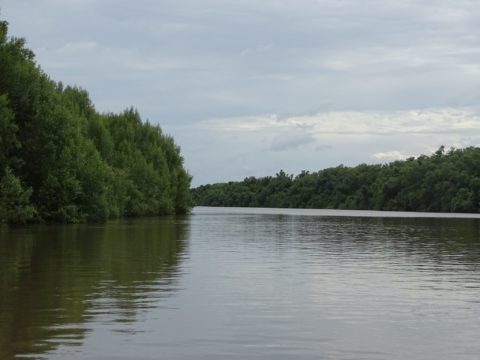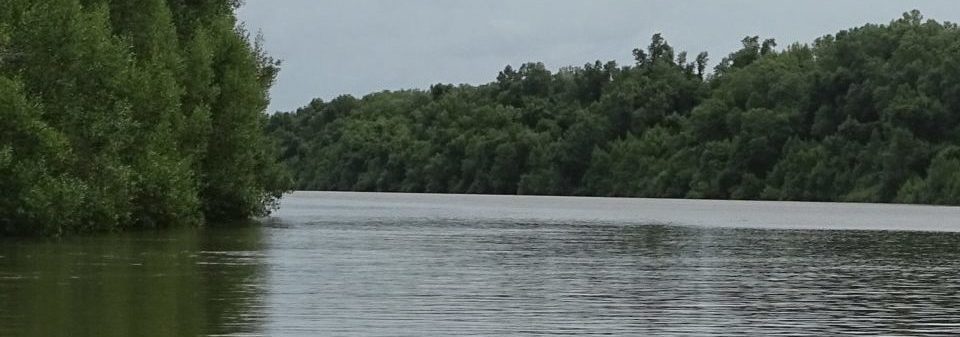A serene and tranquil atmosphere is what welcomes you to Nyamisati village, in Kibiti district, a town about 180kms from Dar es salaam one of Tanzania’s major cities. Standing on the makeshift pier at the mouth of the Rufiji Delta, i can see the lush mangrove forest at a distance, magnificent, tall and green, a refreshing and breath-taking scenery. It is East Africa’s largest mangrove forest Rufiji delta which is home to 53,255 ha of mangrove forest. It is also part of the larger Rufiji-Mafia- Kilwa RAMSAR site, a wetland of International Importance.

It is a bustling Saturday morning and the fish mongers are busy trading in the fish market. Here, there are different types of fish sold; eg Ray fish, African cat fish (hongwe) Haemulidae (dreams), red snapper ( gentleman), King fish, Serranidae among others. The most popular fish here is hongwe retailing for 5000Tsh or 2USD per fish while 1kg of prawns trades for as low as 2000Tsh or less than a dollar. The town, though small appears extra busy with people arriving and others departing. Nyamisati town connects to other islands like; Mchiga, Office, salary, industrial, Simbolaga, and Saniga within the delta and also Mafia which is about 48neutical miles away and is estimated to take about 4 hours to get there.
The mangroves in Rufiji are priceless and they are home to many iconic species, ranging from fish above, migratory water birds many of which are in flight from the European winter, sea turtles nesting on beaches secured by mangrove roots, crabs and shrimp that thrive in mangrove shallows, and wildlife. Despite this they are under threat. When I spoke to 38-year-old Jumanne Yusuf Ikumbi, a father of 4 and the village chairman, I received a tee-total assessment. Mr. Yusuf believes in “no trees no life” and has been working tirelessly to raise awareness on the issues facing the delta and their effects on the mangroves he has grown with. He says “The forest can come back if we work together. We can change and reverse the challenges facing the delta. It might not be 100% but we have to try and it can be achieved over time”. Mr. Yusuf who was born and raised here, recalls how life was before; he describes Mangroves in Swahili as Mikoko a word derived from the sound of a splitting log “ko ko” which he demonstrated quite convincingly .He explains that this name came about in the 18th century when the delta was a bustling trading hub attracting thousands of traders across the region. Using the monsoon winds the Arab community would sail from Asia to the delta in search of mangrove poles and bark that would be used to make paint.

Mr Yusuf continues to narrate how in the early 19th century the Rufiji River flowed towards the southern delta but following heavy rains in the 1980s it changed its flow to the northern delta, which led to an inflow of fresh water and an outflow of the salty water. This change attracted agriculture in the delta, Allowing the communities to engage in alternative livelihoods especially rice farming. Before this, the communities relied only on fisheries as the main source of livelihood. However, this change in water flow regime is said to have introduced an invasive climber species (parquentina) or Nyaganjira as it is locally known, which has a negative impact on mangroves; as it climbs, it covers, suffocates and kills trees. According to the community they currently experience what they refer to as salty seasons between July to December and fresh water seasons from January to June. However, according to Mr. Yusuf there are 7 days every month that water flows in to their farms enabling farming to be done round the year. With the changes in the water flow the northern delta now hosts more mangrove species like Avicennia marina (locally known as Mchu) and Heritiera littoralis(msikundazi) which were initially not found in the area. The northern Delta is also home to other species namely; Sonneratia alba (Mpira) Rhizophora mucronata (Mkoko), Bruguiera gymnorrhiza (Msinzi), Ceriops tagal (Mkaka) and Xylocapus granmatum (Mkomafi).
According to the population census 2015, Rufiji delta has a population of about 12000 people directly depending on the deltas ecosystem for their daily sustenance. The entire delta has approximately 22 villages. Though the most common source of livelihood been fishing, the fish catch has reduced over the years and Mr. Yusuf attributes this to overharvesting of the mangroves. Mr. Yusuf reiterates that there is need to conserve the mangrove forest in the delta for its importance as; it creates healthy breeding sites for fish; farming sites for rice and also provides building poles and timber – all of which translate to income for his other communities that depend on them. According to Mr. Ismail Saidi, the MCA Tanzania Project Manager, the main cause of mangrove loss and degradation in the delta is illegal logging. When we visited Tanzania Forest Service (TFS), we were welcomed by huge piles of logs lying in their premises. It was confirmed that these were seized during patrols and now they await an open market, where licenced business traders will bid to buy them. TFS continues to work within its set mandate to regulate and control mangrove forest harvesting as stipulated by law, but confesses it has not been an easy job and they are in need of more resources. Other causes of mangrove loss and degradation range from agriculture developments for rice and large-scale irrigation schemes to overexploitation by vulnerable local communities for fish and timber, in the absence of alternative income sources. On top of this, the effects of human-induced climate change also loom.
What are we doing?
Wetlands International on 2nd November 2017 launched its new continental programme Mangrove Capital Africa (MCA) during the Western Indian Ocean Marine and Sciences (WIOMSA) scientific symposium held in Dar es Salaam. MCA is a 10-year programme whose vision is: Mangroves and their biodiversity are healthy, improving the livelihoods of millions of people and protecting them against the dangers of climate change. The new program aims to raise awareness on the values of mangroves as well as provide the knowledge and tools necessary for their improved management. The project will also enable community members as well as governments to manage mangroves because they play an important protecting biodiversity as well as support the local economy. The MCA programme targets the coasts of East and West Africa.In East Africa, the Programme will initially focus on Rufiji Delta but it is envisaged to spread to Kenya, Mozambique and Madagascar.
The programme is led by Wetlands International and funded by DOB ecology.

